Microsoft Surface Pro Review
by Anand Lal Shimpi on February 5, 2013 9:00 PM ESTDisplay: Awesome if Calibrated
Surface RT used a 10.6-inch 1366 x 768 display, for Surface Pro Microsoft integrated a full 1920 x 1080 panel of the same size. The increase in resolution is appreciable and you definitely notice it when switching between the two Surface models. Pixel density isn’t class leading, but it’s at least in the right range. On the desktop, Microsoft enables 150% DPI scaling by default which makes everything legible but still a bit odd in applications that don't deal well with fractional DPI scaling. Ideally I would've liked to have seen a clean doubling to avoid this mess.
The higher res display just makes everything sharper in the modern UI, and the 150% DPI scaling in desktop mode makes everything big enough where the higher res isn't a problem there. It's only in those desktop applications that don't properly implement Windows DPI scaling where the higher resolution is a hindrance. I actually ran into this problem using Chrome on the desktop, where my taps wouldn't always map to the right parts of the application (not to mention that Chrome in DPI scaled Windows looks terrible). Thankfully there is always the pen...
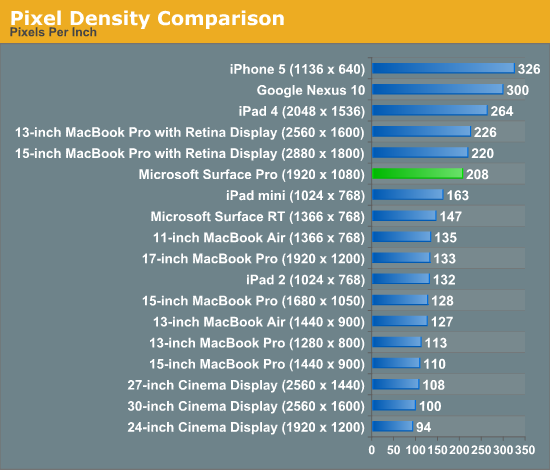
Once again Microsoft doesn’t do any substantial color calibration at the factory, but unlike on Surface RT you can run your own Windows display calibration software on Surface Pro to improve color accuracy if you have the right equipment.
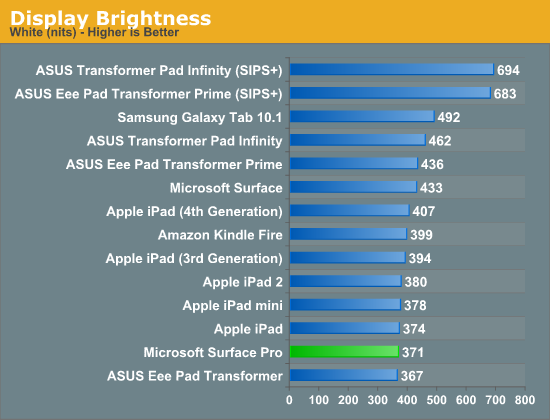
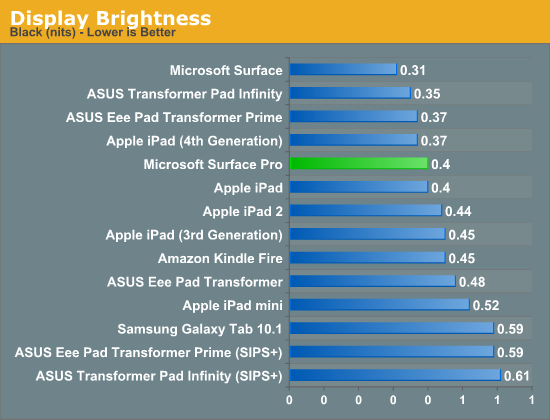
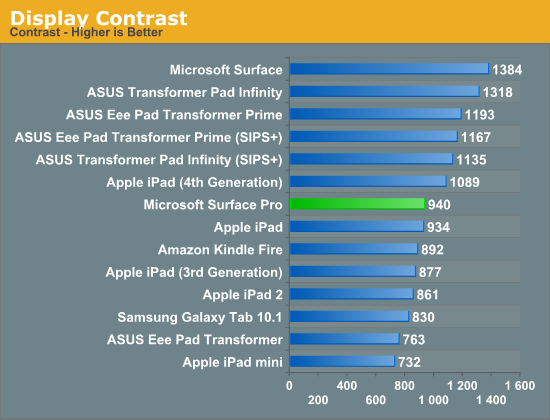
Out of the box my Surface Pro sample had an unusually high white point (~7500K), which negatively impacted its grayscale accuracy. To evaluate color accuracy I turned to our own Chris Heinonen's CalMAN smartphone/tablet workflow. Color accuracy is near identical to Surface RT, which is to say that it’s ok compared to PC notebooks from a couple of years ago but still far behind what you get out of the box from Apple.
Given that the majority of users don’t do any color calibration on their PCs, this becomes a real problem for consumer perception if your tablet doesn’t ship with accurate colors by default.
To see what the panel is capable of I ran it through our standard PC display calibration routine (which I can do since it’s running Windows 8 and is effectively a PC). I then re-ran it through our CalMAN smartphone/tablet workflow and ended up with much more pleasing results. While the display still lagged behind the iPad in one of the tests, it bested Apple’s Retina Display in the other two color accuracy benchmarks.
We'll start off by looking at the calibrated white point for these tablets. What you're looking for here is a number close to 6500K:
The next three charts look at accuracy represented as a difference between various source colors and what's reproduced on the display. The results are presented as average dE2000, with lower numbers being better.
First up is Grayscale performance, here we're looking at the accuracy of black, white and 19 shades of gray spread in between the two extremes:
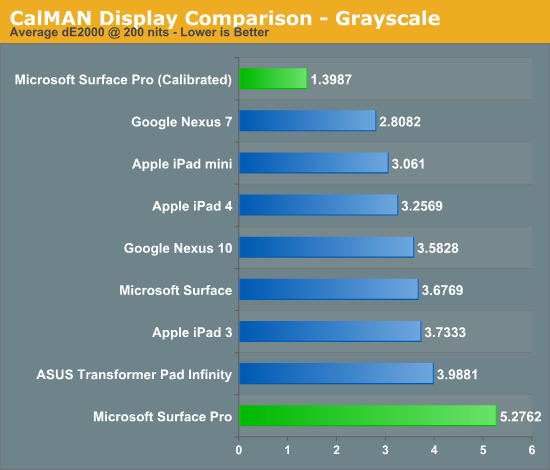
Out of the box grayscale performance is abysmal on Surface Pro. Calibrated accuracy, on the other hand, is just awesome.
First in our color accuracy tests is a saturation sweep. Here we're looking at 20%, 40%, 60%, 80% and 100% saturations of red, blue, green, magenta, yellow and cyan.
Our saturation sweep is the only test where even a calibrated Surface Pro can't match the iPad, it does do a lot better than Surface Pro without any color calibration however. Out of the box Surface Pro is considerably worse than any Apple tablet.
Gamut CIE Chart

Saturation CIE Chart
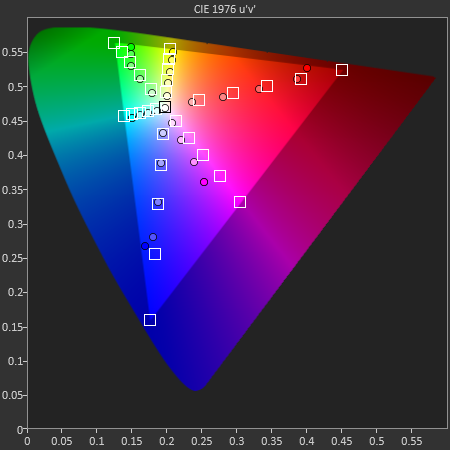
For our final accuracy test we're looking at the difference between a Gretag Macbeth colorchecker chart and the rendered swatches on these displays. Once again, lower numbers are better.
Out of the box Surface Pro and Surface RT are near identical here, and similar to the Nexus 10. With a good suite of calibration tools and supported hardware under Windows 8, Surface Pro has the potential to easily outperform the iPad if given the opportunity.
GMB Color Checker
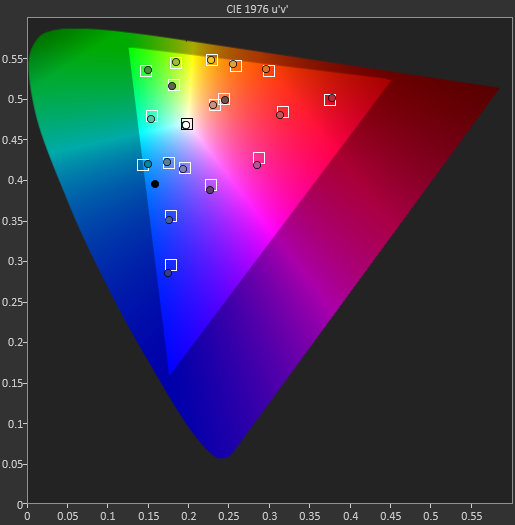
Surface Pro’s panel has real potential, it just needs a calibration pass - which is honestly something Microsoft should be doing these days, not the end user.
Mini DisplayPort but No Thunderbolt
Surface RT featured a single video output in the form of a micro HDMI port. Surface Pro adopts a mini DisplayPort output instead, and will have adapters to enable DVI and HDMI support.
The miniDP output immediately activates as soon as you plug a display into it. I sometimes had issues with display resolutions being set sub optimally, but generally speaking the process was as plug and play as you can get.
I did notice some visual tearing on the Surface Pro display when connected to an external HDMI monitor, similar to what I saw with Surface RT but not nearly as bad. I’m beginning to think something is a bit wonky with Windows 8’s multi-monitor support. What’s interesting is I didn’t see the issue on all displays, which is more than I can say for Surface RT. Update: It looks like this is hardware related. Even if the internal and external panels have the same refresh rate, Intel's HD 4000 won't guarantee that the refreshes will happen at the same time - which is why we see tearing. The tearing should only be present in clone mode, not extended desktop (I'll verify this shortly). It seems like Tegra 3 is worse in this regard, which is why the issue was so much more prevalent on Surface RT. I need to check other Ivy Bridge platforms and under OS X to see if the problem is as prevalent there as well.
The only disappointment here is Microsoft opted against integrating Thunderbolt into Surface Pro. I feel like Thunderbolt would’ve made a ton of sense in a device like Surface Pro, enabling one cable connection to both an external display and high-speed external storage. Given that Thunderbolt adoption remains fairly limited in the PC space I don’t think this is a huge loss for most of Microsoft’s target customer base, but I do feel like it’d be a good way of future proofing the device. The alternative that Surface Pro offers is the combination of miniDP and USB 3.0, which realistically speaking is probably good enough for most users. From a cost of integration standpoint vs. the number of users who would pay for it, it probably didn’t make sense for Microsoft to include Thunderbolt in Surface Pro, but that doesn’t change the fact that I wish it was there. It’d be nice for Apple not to be the only company really pushing Thunderbolt.
Camera Quality
Surface Pro, like Surface RT before it, features two integrated 720p cameras with no flash. Admittedly I didn't spend a ton of time taking photos with Surface Pro but imaging quality is just really bad compared to what you'll get out of an iPad 4. The results are borderline ok for use on the web but that's pretty much it, and forget about decent low light performance.


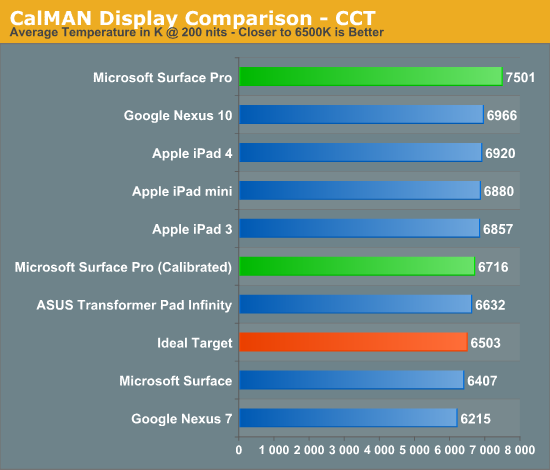
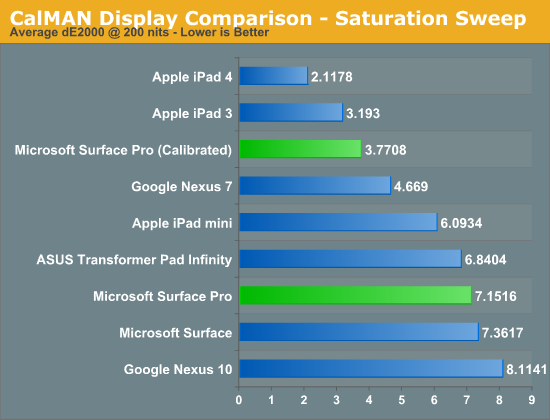
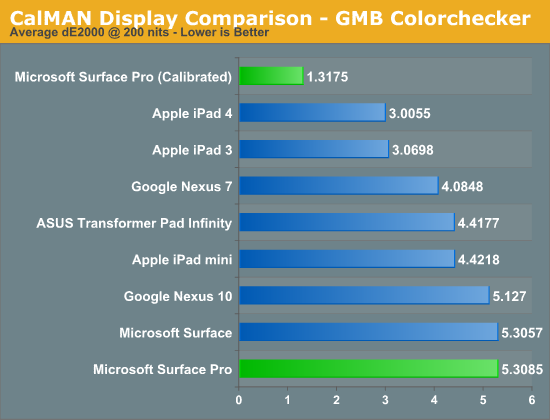










228 Comments
View All Comments
DogmaHunter - Thursday, February 7, 2013 - link
You'ld be surprised.It wouldn't be the first time I see pc's in hospitals or private practices rendering a 3d model of for example shoulder joints or whatever.
Death666Angel - Thursday, February 7, 2013 - link
Consider me surprised. :DI thought that tablets for medical purposes would serve as clients to a server running in the background.
@cknobman: what kind of company do you work for and what did the Atom tablets fail to do? I agree completely that Atom is still anemic. But it would be good enough for my wife for example. Her flash heavy websites would suffer a bit but there would be pros in other areas. :)
Jollydogg - Wednesday, February 6, 2013 - link
I'm a nurse. The last thing I'd want to do is sit down and do productivity work on this tablet during or after a long shift. I own a Nexus 7 (from which I'm using right now while out to lunch) to get me through times I'm not at a PC.I'm also in grad school. I can see one of these being AWESOME for someone who is continually out of the house and is in a grad program that requires short, frequent sessions of checking PDFs and online articles. Then again, any used laptop can do the same thing.......and for far less.......that includes a keyboard.......for far less money........see what I mean?
I think the design is conflicting. Its like its meant for a very narrow, specific target audience, and even at that, its not competitively priced. Its meant to be a laptop replacement with tablet/portability convenience, yet the situations in which you would need to be in to use it effectively are basically the same ones in which you use a laptop. Somewhere stable and comfortable.
I mean, I love this concept, and I really, really want one. I just can't really justify the cost, then having to pay additional for a keyboard, and then also only having 23gb of use able space. I'm not a space hog, but damn, if my unit is going to substitute as a laptop, I'm gonna need more than that.
Jollydogg - Wednesday, February 6, 2013 - link
When I meant used effectively, I meant used effectively for productivity, not just common usage.andrewaggb - Wednesday, February 6, 2013 - link
Any used laptop will be heavy and get lousy battery life. 5-6 Hours battery life is pretty good by laptop standards.It's not that expensive compared to an ipad with the same storage, and intel charges $225 for the cpu, which is basically the entire reason for the price difference between the ipad and surface pro.
I think it'll sell fairly well for a device in it's price range.
Alucard291 - Tuesday, February 19, 2013 - link
5-6 hours of battery is about double compared to this... Shocking piece of... technology...DogmaHunter - Thursday, February 7, 2013 - link
You can free up another 20gb by making a copy of the recovery partition.And I think you miss the point about its versatility... the whole point of it is to be usable as a tablet, a laptop and even as a desktop by attaching additional monitors. And all that without needing to change devices and thus also shifting files around.
You can be working at your desk as if behind a desktop, unplug the screen and take your surface into a meeting. You can go to another physical desk next to a collegue, plug in their and you're back on a desktop setting.
No more running around with docking stations, no more syncing files through cloud or USB, no more cables everywhere.
I think this is the wet dream of mobility.
KoolAidMan1 - Thursday, February 7, 2013 - link
iPads have been used in hospitals for a few years now, things like entering into patient records remotely.You don't need an i5 for that sort of thing, you need something very light with tons of battery life that will either run your applications or a web browser.
DogmaHunter - Thursday, February 7, 2013 - link
I've been in a lot of companies for my job as IT consultant, including hospitals, and I have never seen ipads (or anything from apple) being used for another purpose then the "flash factor" by sales people.And when they return from their sales talk, they sit behind a desk with a windows laptop or desktop.
Reason is simple: they don't want foreign devices (ie: non-windows machines) on their network for security purposes.
While I'm sure you can find a few businesses that actually uses ipads and stuff like you described, I think you'll find these to be a very small minority... most likely with a frustrated and/or angry IT admin.
seapeople - Sunday, February 10, 2013 - link
I think you mistyped your comment... you did mean to say that you've been in a lot of caves for your job as an IT consultant, right?I don't see any other way that you haven't seen the wave of large/small business iPad usage popping up everywhere in your area.